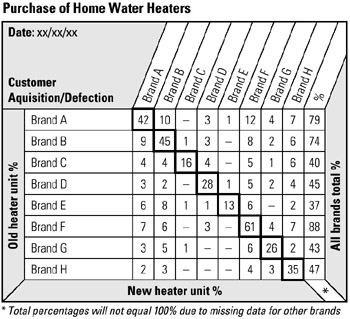Tool 52: Customer Acquisition-Defection Matrix
| AKA | N/A |
| Classification | Analyzing/Trending (AT) |
Tool description
The customer acquisition-defection matrix is a very useful tool to gauge customer brand loyalty, to track competitors' market share, and to identify trends in customer needs, expectations, or behavior.
Typical application
-
To identify customer product purchase flows among different product brand names in comparison to the company's existing market share.
-
To plot market share data of previous product purchase percentage to new product purchase percentage.
-
To measure percent change in product demand; to track customer defection rates.
-
To develop a benchmarking plan for targeting the strongest competitors.
Problem-solving phase
| → | Select and define problem or opportunity |
| → | Identify and analyze causes or potential change |
| Develop and plan possible solutions or change | |
| → | Implement and evaluate solution or change |
| → | Measure and report solution or change results |
| Recognize and reward team efforts |
Typically used by
| 4 | Research/statistics |
| Creativity/innovation | |
| 5 | Engineering |
| Project management | |
| Manufacturing | |
| 3 | Marketing/sales |
| Administration/documentation | |
| Servicing/support | |
| 2 | Customer/quality metrics |
| 1 | Change management |
before
-
Data Collection Strategy
-
Measurement Matrix
-
Interview Technique
-
Surveying
-
Questionnaires
after
-
Customer Satisfaction Analysis (CSA)
-
Customer-First-Questions (CFQ)
-
Benchmarking
-
Failure Mode Effect Analysis
-
Countermeasures Matrix
Notes and key points
-
The data collection process should include the search and verification of secondary data, such as market share studies, company annual reports, trendlines, or any other summarized customer behavior information.
Step-by-step procedure
-
STEP 1 The first step requires an extensive and highly focused data collection on the product under analysis. Market share data, customer buying behavior, and market/technology trends need to be examined.
-
STEP 2 Product-specific data such as previous ownership percentage, repurchase percentage, and competitors' gain/loss percentages are collected.
-
STEP 3 A customer acquisition-defection matrix is constructed and percentages listed in the appropriate squares associated with particular brand names. See example Purchase of Home Water Heaters.
-
Brand A is the company's location on the matrix. It shows that 42 percent of Brand A customers purchased another Brand A home water heater from this company, 10 percent purchased Brand B, 7 percent purchased Brand C, etc.
-
Referring to Brand B on the matrix, 45 percent of all Brand B heater customers repurchased a Brand B heater, 9 percent purchased a Brand A heater, 8 percent purchased a Brand F heater, and so on.
-
-
STEP 4 Next, total all row percentages for each brand and indicate this total in the percentage column.
-
STEP 5 Lastly, check all plotted data and calculations, and date the matrix.
Example of tool application
Purchase of Home Water Heaters

EAN: 2147483647
Pages: 326